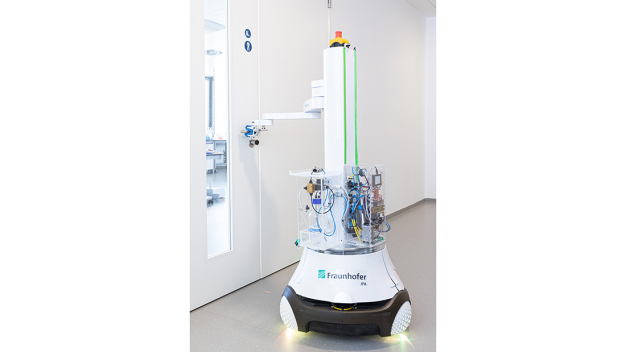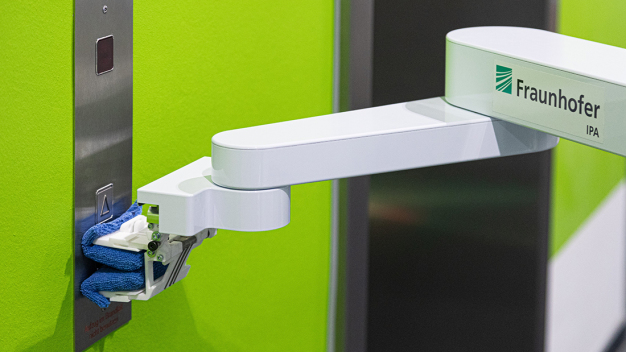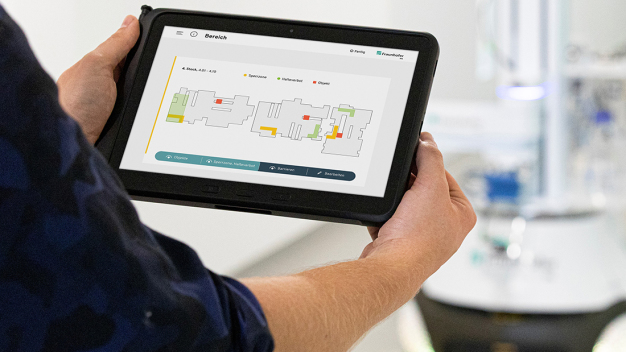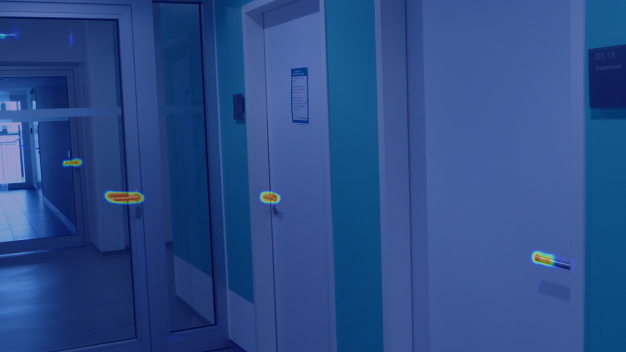- R+D & Community of Interest
Fraunhofer IPA presents disinfection robot “DeKonBot”
In order to contain the spread of the coronavirus, the research institute in Stuttgart has developed the prototype of a mobile cleaning and disinfection robot in a short time. It navigates autonomously to potentially contaminated objects, such as door handles, and disinfects them thoroughly. The robot is gentle on resources and time-saving.
The new prototype of the mobile disinfection robot “DeKonBot” is an automation solution that independently cleans and disinfects potentially contaminated areas such as door handles, light switches, or elevator buttons. Compared to cleaning by hand, the use of robots reduces the risk of infection for the cleaning staff and at the same time ensures that the cleaning task is carried out reliably and traceably. The continuous use of the robot, even during the night, means that cleaning jobs can be performed more frequently than if carried out manually.
Targeted and safe disinfection
Compared to available robot solutions on the market, DeKonBot has a few different features. On the one hand, it cleans relevant surfaces in a targeted and direct manner and does not spray the disinfectant over large areas in the room like some other robots. This not only saves on disinfectants and time because the surface to be cleaned is limited to the essentials, but also prevents hazards such as slipping on damp surfaces or inhaling potentially harmful chemicals. On the other hand, DeKonBot can be used safely in the presence of people. For safety reasons, disinfection robots that use UV rays to kill viruses, for example, require an environment where no people are present.
In order for DeKonBot to work successfully, it is initially trained in its new operating environment with the help of a tablet that can be operated without expert robotics knowledge. First of all, the member of operating staff navigates the robot once through the environment, during which it independently creates a map of its operating environment. In addition, the user “shows” the robot the objects to be cleaned and the cleaning movement to be performed: For this purpose, the user guides the robot arm with the disinfection tool to the door handle, for example, and moves the tool as required to clean it. The robot saves the path and is subsequently able to repeat it independently.
The objects to be cleaned are currently still recognized by means of so-called “tags”, i.e. small, black-and-white labels. The robot positions itself relative to these tags. In the future, tags will no longer be needed. Instead, methods recently developed at Fraunhofer IPA will be used, which on the one hand enable these objects to be automatically recognized in camera data. On the other hand, a new 3D sensor, which was developed in the course of the project, recognizes the objects to be cleaned and their position in the room better than other sensors available on the market, even if these objects have a metallic, reflective surface.
Rapid joint development
The prototype is the result of a joint development of the IPA departments “Robot and Assistive Systems”, “Laboratory Automation and Biomanufacturing Engineering” together with “Ultraclean Technology and Micromanufacturing”. DeKonBot received funding from the Fraunhofer-Gesellschaft's internal “Anti-Corona” program, in which it is carrying out comprehensive research and innovation activities to combat the pandemic.
The development of the service robot proceeded rapidly. Already in April of this year, a first feasibility study was carried out, in which a simple spray tool was still used for disinfection. “Just four months later, we were able to put the disinfection robot with its new wiping tool into operation - despite the limitations that the coronavirus pandemic also caused for us Fraunhofer employees”, explains Birgit Graf, Manager of the “Household and Assistive Robotics” group and manager of the DeKonBot project.
The development of the prototype profited from extensive preliminary work carried out by the institute in the field of mobile service and cleaning robotics. For example, the mobile platform of the robotic home assistant Care-O-bot® 4 was used, which is already being sold as a serial product by an IPA spin-off. Existing software modules for navigation, 3D object recognition and manipulation could be further developed specifically for the application. Currently, first field tests are being performed with the robot in the offices at Fraunhofer IPA. Later, employees from a cleaning company will test the robot in an external building. Until the end of the project in February 2021, the robot will be further optimized based on the test results. Measurements of the bacterial load in the disinfected areas will be used to verify the benefit of the robot.
In addition, the research project “Mobile Disinfection” (MobDi), also funded by the Fraunhofer-Gesellschaft and starting in October this year, will be focusing on and further developing DeKonBot technologies. In particular, new disinfection methods and tools, as well as more complex detection and planning methods, will be developed in the course of the one-year project period, thus enabling disinfection robots to plan the cleaning and disinfection process systematically.
Production readiness in view
DeKonBot has not yet reached its full range of functions but researchers at Fraunhofer IPA have already developed a concept for a later serial product. “Together with interested companies, we would like to put the service robot into practice and thus make a contribution to restarting public life even in times of the coronavirus,” says Graf, stating the next goals. Several cleaning companies that were actively involved in the development of the robot have already expressed their interest in using DeKonBot.
![]()
Fraunhofer-Institut für Produktionstechnik und Automatisierung IPA
Nobelstraße 12
70569 Stuttgart
Germany
Phone: +49 711 970 1667
email: joerg-dieter.walz@ipa.fraunhofer.de
Internet: http://www.ipa.fraunhofer.de












